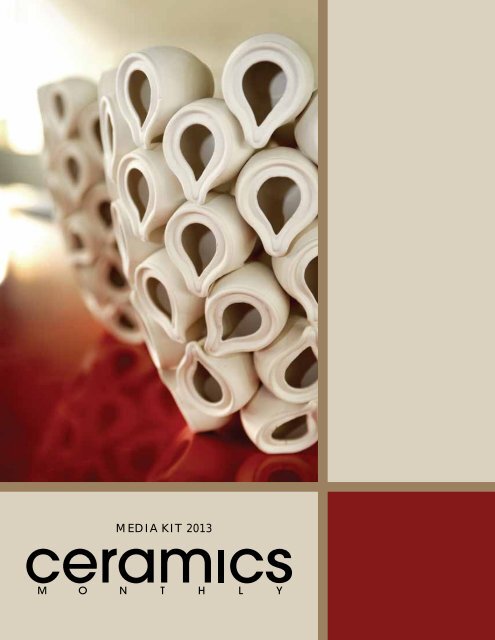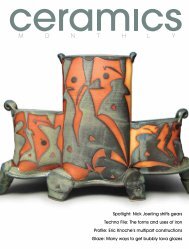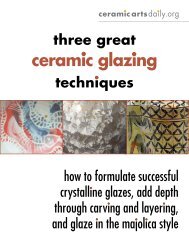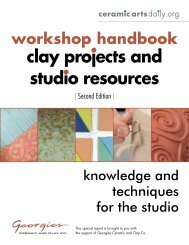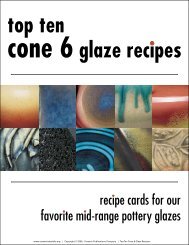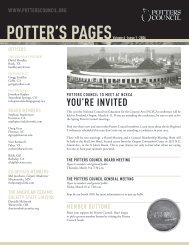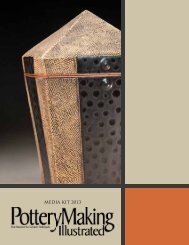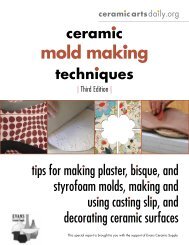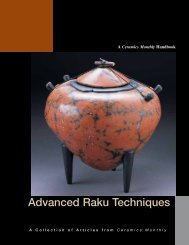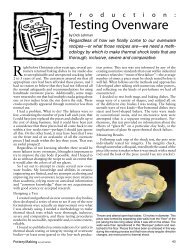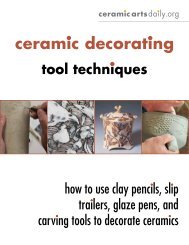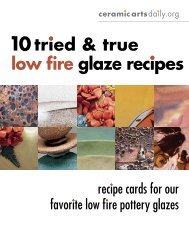editorial experts and contents - Ceramic Arts Daily
editorial experts and contents - Ceramic Arts Daily
editorial experts and contents - Ceramic Arts Daily
You also want an ePaper? Increase the reach of your titles
YUMPU automatically turns print PDFs into web optimized ePapers that Google loves.
<strong>editorial</strong> <strong>experts</strong> <strong>and</strong> <strong>contents</strong><br />
1 2013 <strong>Ceramic</strong>s Monthly Media Kit<br />
Media kit 2013
WelcoMe<br />
ExplorE,<br />
DiscovEr &<br />
ExpanD<br />
Culture of Clay<br />
Charlie Spahr<br />
Publisher<br />
Sherman Hall<br />
Editor<br />
2 2013 <strong>Ceramic</strong>s Monthly Media Kit<br />
Celebrate the ceramic arts with <strong>Ceramic</strong>s<br />
Monthly’s dedicated community of artists,<br />
enthusiasts, collectors, <strong>and</strong> instructors.<br />
Explore how you can become central to our<br />
mission to provide a venue where everyone<br />
in studio ceramics can connect to share ideas,<br />
discoveries, <strong>and</strong> information.<br />
Discover the hunger for innovation our<br />
readers have in order to bring their artistic<br />
vision to reality. When you join this community,<br />
you help readers make their visions a reality.<br />
Exp<strong>and</strong> your organization’s reach by<br />
becoming a valued resource in helping the<br />
ceramic art world grow <strong>and</strong> thrive.<br />
Get ready, get involved <strong>and</strong> get results.<br />
Cover Image Artist: Xeve Aebi Photographer: Gunter Binsack<br />
Copyright: Kahla Thüringen Porcelain LLC<br />
CONTENTS<br />
Our Readers 3<br />
Reader Activities 4<br />
Opinion Leaders 5<br />
Purchasing Activities 6<br />
Subscriber Activities 7<br />
Editorial Mission 8<br />
2013 Editorial Calendar 9<br />
2013 Advertising Rates 10<br />
Production Specifications 11<br />
<strong>Ceramic</strong> <strong>Arts</strong> Yearbook <strong>and</strong><br />
Buyers Guide 2013 12<br />
<strong>Arts</strong> guides 13<br />
<strong>Ceramic</strong> <strong>Arts</strong> <strong>Daily</strong> 14<br />
Contact Information 16
our readers<br />
To improve their<br />
skills, 78% of <strong>Ceramic</strong>s<br />
Monthly readers expect<br />
to take classes or attend<br />
workshops in the next<br />
two years.<br />
How <strong>Ceramic</strong>s Monthly<br />
subscribers are involved with<br />
ceramic arts*<br />
Professional (derive income) 60%<br />
Educator/teacher 35%<br />
Enthusiast 37%<br />
* Individuals can be in more than one category<br />
How subscribers gained<br />
their skills in the ceramic arts*<br />
Workshops 49%<br />
College/University 62%<br />
Art/Community Center 40%<br />
Self-taught 38%<br />
3 2013 <strong>Ceramic</strong>s Monthly Media Kit<br />
23% Commercial/Private Studio<br />
10% Taught by Friend/Relative<br />
* Individuals can be in more than one category<br />
Source: The <strong>Ceramic</strong>s Monthly subscriber survey July 2012.<br />
rEacH<br />
CeramiC artists<br />
Skill level in making ceramic art<br />
44% Intermediate<br />
(mastered some<br />
aspects)<br />
51% Advanced<br />
(mastered<br />
most aspects)<br />
5% Beginner<br />
(learning fundamentals)<br />
Artist: Kristen Kieffer
eader actiVities<br />
rEacH YoUr<br />
tarGet<br />
MarKET<br />
<strong>Ceramic</strong>s Monthly subscribers<br />
look forward to every issue<br />
4 2013 <strong>Ceramic</strong>s Monthly Media Kit<br />
88%<br />
Read All issues<br />
<strong>Ceramic</strong>s Monthly subscribers<br />
go through most or all of every issue<br />
74.6% Front to back<br />
2.2% Look at half the pages<br />
0.5% Less than half/few or none<br />
Source: The <strong>Ceramic</strong>s Monthly subscriber survey July 2012 .<br />
22.7% Look at most pages<br />
1.3%<br />
Read half<br />
the issues<br />
10%<br />
Read most<br />
issues<br />
In addition to the paid monthly circulation<br />
<strong>and</strong> retail distribution, <strong>Ceramic</strong>s Monthly<br />
also offers bonus distribution at highprofile<br />
events, such as the NCECA<br />
conference <strong>and</strong> SOFA expositions.<br />
<strong>Ceramic</strong>s Monthly reaches<br />
more than 125,000<br />
subscribers <strong>and</strong> pass-along<br />
readers<br />
1. Total Paid/Requested Circulation 21,619<br />
2. Average Pass-Along Recipients/Copy 4.81<br />
3. Total Pass-Along Recipients/Issue 103,987<br />
TOTAL MARKET REACH 125,606<br />
From the Publisher’s Statement for the October<br />
2012 issue. Pass-along information from the<br />
<strong>Ceramic</strong>s Monthly subscriber survey July 2012.<br />
Artist: Justin Teilhet
opinion leaders<br />
sUbscribErs<br />
influenCe peers<br />
How <strong>Ceramic</strong>s Monthly subscribers are or have been<br />
involved in teaching/training other artists*<br />
Teaching courses 41%<br />
Teaching workshops, seminars 36%<br />
Delivering presentations at exhibitions 29%<br />
Delivering presentations at less formal meetings 31%<br />
Training others at craft shops, art centers 33%<br />
Training others one-on-one (friend, relative, etc.) 50%<br />
Mentoring others 31%<br />
*Individuals can be in more than one category<br />
<strong>Ceramic</strong>s Monthly subscribers are sought<br />
out for advice on ceramic art<br />
PRODUCTS, EQUIPMENT, SUPPLIERS<br />
14%<br />
Rarely or<br />
Never<br />
32%<br />
Frequently<br />
12%<br />
Very Frequently<br />
5 2013 <strong>Ceramic</strong>s Monthly Media Kit<br />
42%<br />
Sometimes<br />
<strong>Ceramic</strong>s Monthly subscribers are sought<br />
out for advice on ceramic art<br />
DESIGN, TECHNIQUES, APPROACHES<br />
33%<br />
Frequently<br />
Artist: George Lowe<br />
12%<br />
Rarely or<br />
Never<br />
12%<br />
Very Frequently<br />
43%<br />
Sometimes
purchasing actiVities<br />
YoUr proDuCts<br />
anD serViCes<br />
Count<br />
Ownership of ceramic arts materials,<br />
products, <strong>and</strong> equipment<br />
Prepared clay 93%<br />
Raw material 75%<br />
Prepared glazes 65%<br />
H<strong>and</strong> tools 98%<br />
Molds 47%<br />
Clay mixers/pug mills 21%<br />
Kilns 79%<br />
Wheels 80%<br />
Slab Roller 42%<br />
Extruder 39%<br />
Studio furniture 61%<br />
(racks, shelves, tables, etc.)<br />
Actions subscribers have taken based on<br />
advertisements in <strong>Ceramic</strong>s Monthly<br />
Phoned or emailed an advertiser or visited their website 68%<br />
Discussed any advertised products with other ceramic artists 55%<br />
Saved an advertisement for future reference 50%<br />
Passed information in an ad onto other ceramic artists 40%<br />
Other 5%<br />
Source: The <strong>Ceramic</strong>s Monthly subscriber survey July 2012.<br />
6 2013 <strong>Ceramic</strong>s Monthly Media Kit<br />
Currently Will<br />
Purchased in the likely/possibly<br />
within purchasing purchase<br />
past 24 mos. process next 24 mos.<br />
Prepared clay 87% 25% 41%<br />
Raw materials 83% 18% 37%<br />
Prepared glazes 81% 18% 43%<br />
H<strong>and</strong> tools 89% 14% 35%<br />
Molds 76% 6% 31%<br />
Clay mixers/pug mill 44% 3% 57%<br />
Kilns 61% 7% 40%<br />
Wheels 70% 3% 31%<br />
Slab rollers 50% 6% 48%<br />
Extruders 41% 12% 49%<br />
Studio furniture 60% 7% 46%<br />
Artist: Mark Knott
suBscriBer actiVities<br />
rEaDErs<br />
GlaZe anD<br />
fire<br />
Mixing/purchasing glazes<br />
Trend in expenditures<br />
(next two years)<br />
Increase 36%<br />
No change 46%<br />
Decrease 17%<br />
53%<br />
Mix own & buy<br />
premixed<br />
26%<br />
Buy<br />
premixed<br />
7 2013 <strong>Ceramic</strong>s Monthly Media Kit<br />
18%<br />
Mix own<br />
3%<br />
No involvement<br />
with glazes<br />
97% of our readers have h<strong>and</strong>s-on involvement with glazes<br />
96% of our audience have h<strong>and</strong>s-on involvement with kilns<br />
Glaze firing ranges used<br />
High-fire (cone 8-12) 50%<br />
Mid-fire (cone 4-7) 72%<br />
Low-fire (cone 08-04) 42%<br />
China paints/lusters (cone 022-018) 9%<br />
Raku 34%<br />
Pit/Barrel Firing 18%<br />
88% of <strong>Ceramic</strong>s Monthly’s<br />
readers take action based<br />
on ads they’ve seen in<br />
<strong>Ceramic</strong>s Monthly.<br />
Types of kilns owned or used<br />
Electric 94%<br />
Gas 40%<br />
Raku 32%<br />
Wood-fired 13%<br />
Pit-fired 13%<br />
Other 8%<br />
Artist: Sunshine Cobb
<strong>editorial</strong> Mission<br />
<strong>Ceramic</strong>s Monthly<br />
Every issue meets the readers’ needs<br />
48 september 2011 www.ceramicsmonthly.org www.ceramicsmonthly.org september 2011 49<br />
GLAZE ARTICLES<br />
Recipes are always popular—<strong>and</strong> we deliver them in every issue —but we also teach readers how <strong>and</strong> why<br />
the recipe works, so they can explore on their own <strong>and</strong> exp<strong>and</strong> their palette.<br />
all about iron by<br />
TECHNO FILE<br />
Celadons<br />
at six<br />
by John Britt<br />
Celadon glazes are some of the most popular glazes in ceramics. In particular,<br />
transparent blue celadons have a very delicate, beautiful color that<br />
shows carving very nicely. But celadons aren’t just blue; they can range<br />
from blue to blue-green to gray-blue to gray-green to green to amber, <strong>and</strong><br />
even to white. They often have distinctive crackle patterns that are sought<br />
after but can also be craze-free.<br />
Celadons originated in China thous<strong>and</strong>s of years ago <strong>and</strong> were meant<br />
to mimic jade. The Lung-chuan (Longquan) satin green celadons were<br />
important Chinese exports for over 500 years. The term “Celadon” is a<br />
European name thought to have derived from a character in a French play<br />
who wore gray-green ribbons over his cloak. However, there are several<br />
competing theories of its origin.<br />
Technically, celadons are feldspathic transparent high-fire glazes that<br />
are colored with iron <strong>and</strong> fired in reduction. This differentiates them from<br />
transparent copper greens known as Oribe, but both glaze names denote<br />
a type of ware as well as a color of glaze. Celadons were thought to have<br />
been made from the local clay body <strong>and</strong> ash, but as the glaze traveled to<br />
Korea <strong>and</strong> Japan, potters began using porcelain stone (a naturally occurring<br />
decomposed feldspathic rock) in the glaze.<br />
Purists would say that a cone 6 celadon is impossible, since, by definition,<br />
it is high fired, but if we take a more practical approach <strong>and</strong> widen our<br />
definition of celadon to a transparent blue-green glaze colored with iron or<br />
other oxides, then we can include cone 6 celadons in reduction or oxidation.<br />
Since I have worked extensively with cone 10 blue celadons, <strong>and</strong> know<br />
the principles necessary to produce that glaze, I assumed that those same<br />
principles could be used to make a cone 6 celadon. The idea is to select<br />
a glaze with high potassium (better chances for blue), high silica, small<br />
amounts of iron, <strong>and</strong> low titanium (to prevent opacifying the glaze <strong>and</strong><br />
to prevent the iron from going green to brown). Also, a small amount of<br />
tin oxide <strong>and</strong> barium carbonate improve the blue color. Apply it thickly<br />
(two to three coats; 1⁄8–3⁄16 inches or 3–5mm) on a clay body also low in<br />
titanium. This means that you should use Grolleg kaolin in both the clay<br />
body <strong>and</strong> the glaze recipe. Fire in an early reduction cycle, using heavy<br />
reduction (0.75–0.80 oxygen probe reading) beginning at cone 012–010<br />
(1582–1657°F; 861–903°C), then hold moderate reduction (0.70–0.75<br />
Iron is everywhere in many different forms, but that doesn’t mean it has to be boring—or even brown.<br />
De ning the Terms<br />
Iron—The fourth most common element in the earth’s crust <strong>and</strong> the<br />
most common element (in terms of mass) on the planet, comprising<br />
35% of the earth’s core.<br />
Melting Point: 2795°F (1535°C )<br />
Toxicity: Non-toxic<br />
Forms of Iron<br />
Iron oxide is the most common colorant in ceramics. It is so ubiquitous<br />
that it is very diffi cult to fi nd a material without some iron—it’s found<br />
in almost everything from feldspars to kaolin to ball clays, earthenware<br />
clays, <strong>and</strong> many colorants. In fact, many materials require expensive<br />
processing to reduce the amount of iron to acceptable levels.<br />
Iron is a very active metal that combines easily with oxygen. That<br />
means it is very sensitive to oxidation <strong>and</strong> reduction atmospheres,<br />
producing a wide range of glaze colors <strong>and</strong> effects from off white,<br />
light blue, blue, blue-green, green, olive, amber, yellow, brown,<br />
russet, tea-dust, black, iron saturate, iron spangles, iron crystalline<br />
(goldstone/tiger’s eye), oil spot, hare’s fur, kaki (orange), leopard<br />
spotted kaki, tan, black seto, pigskin tenmoku, shino, gray (Hidashi),<br />
iridescent, silver, gold, etc. Iron also plays a major role in clay bodies,<br />
slips, terra sigillata, <strong>and</strong> fl ashing slips.<br />
There are three major forms of iron used in ceramics: red iron oxide<br />
(Fe203), black iron oxide (FeO or Fe3O4), <strong>and</strong> yellow iron oxide (FeO<br />
(OH)). There are different mesh sizes <strong>and</strong> grades, <strong>and</strong> each contains<br />
varying degrees of impurities that can make a signifi cant difference<br />
in the results you get.<br />
The most interesting thing about iron is that it can act both as a<br />
refractory <strong>and</strong> a fl ux. As red iron oxide, Fe2O3, it is an amphoteric<br />
(refractory/stabilizer) similar in structure to alumina (Al2O3). But if it is<br />
reduced to black iron oxide (FeO) it acts as a fl ux similar in structure<br />
to calcium oxide (CaO). What this means is that a tenmoku glaze<br />
with 10% red iron oxide will be a stiff black glaze if fi red in oxidation<br />
because the iron oxide acts as a refractory. But, if the same glaze is<br />
fi red in reduction that 10% Fe2O3 will be reduced to FeO, changing it<br />
to a fl ux, which will make it a glossy brown/black glaze that may run.<br />
Another interesting property of iron oxide is that if it is fi red in<br />
oxidation it will remain Fe2O3 until it reaches approximately 2250°F<br />
(approximately cone 8) where it will then reduce thermally to Fe3O4<br />
on its way to becoming FeO. The complex iron oxide molecule simply<br />
cannot maintain its state at those temperatures. This results in the<br />
release of an oxygen atom that will bubble to the surface of the hot<br />
glaze <strong>and</strong> pull a bit of iron with it. When it reaches the surface the<br />
oxygen releases the iron as it leaves the glaze, creating spots with<br />
greater concentrations of iron oxide. This is what creates an oil spot<br />
glaze. This reaction can easily be seen through the spy hole of a kiln<br />
or with draw tiles. There is an obvious <strong>and</strong> unmistakable bubbling.<br />
If heated further, these spots begin to melt <strong>and</strong> run down the pot,<br />
creating a distinctive “hare’s fur” effect.<br />
Have a technical topic you want explored further in Techno File?<br />
Send us your ideas at <strong>editorial</strong>@ceramicsmonthly.org.<br />
14 march 2011 www.ceramicsmonthly.org<br />
8 2013 <strong>Ceramic</strong>s Monthly Media Kit<br />
John Britt<br />
Iron Glazes<br />
It would be impossible to show all iron glazes in this article but<br />
highlighting a few will give you a glimpse of the wide variety.<br />
RON ROY BLACK<br />
Cone 6<br />
Talc. . . . . . . . . . . . . . . . . . . . . . . . . . . 3 %<br />
Whiting . . . . . . . . . . . . . . . . . . . . . . . 6<br />
Ferro Frit 3134 . . . . . . . . . . . . . . . . . . 26<br />
F-4 Feldspar . . . . . . . . . . . . . . . . . . . . 21<br />
EPK Kaolin . . . . . . . . . . . . . . . . . . . . . 17<br />
Silica . . . . . . . . . . . . . . . . . . . . . . . . . 27<br />
100 %<br />
Add: Cobalt Carbonate . . . . . . . . . . . . 1 %<br />
Red Iron Oxide . . . . . . . . . . . . . . . 9 %<br />
FAKE ASH<br />
Cone 6 reduction<br />
Bone Ash . . . . . . . . . . . . . . . . . . . . 5.0 %<br />
Dolomite . . . . . . . . . . . . . . . . . . . . 24.5<br />
Gerstley Borate . . . . . . . . . . . . . . . 10.0<br />
Lithium Carbonate . . . . . . . . . . . . . 2.0<br />
Strontium Carbonate . . . . . . . . . . . 9.5<br />
Ball Clay . . . . . . . . . . . . . . . . . . . . . 21.0<br />
Cedar Heights Red Art . . . . . . . . . . 28.0<br />
100.0 %<br />
CHINESE CRACKLE (KUAN)<br />
Cone 10 reduction<br />
Custer Feldspar . . . . . . . . . . . . . . . . . . 83 %<br />
Whiting . . . . . . . . . . . . . . . . . . . . . . . 9<br />
Silica . . . . . . . . . . . . . . . . . . . . . . . . . 8<br />
100 %<br />
Add: Zircopax (optional) . . . . . . . . . . . 10 %<br />
Adding small amounts of red iron oxide to<br />
this feldspathic base <strong>and</strong> fi ring in reduction<br />
will result in the following:<br />
Blue Celadon: 0.5%–1.0%<br />
Blue–Green: 1–2%<br />
Olive to Amber: 3–4%<br />
Tenmoku: 5–9%<br />
Iron Saturate: 10–20%<br />
KETCHUP RED (JAYNE SHATZ)<br />
Cone 6 oxidation<br />
Gerstly Borate . . . . . . . . . . . . . . . . . . . 31 %<br />
Talc. . . . . . . . . . . . . . . . . . . . . . . . . . . 14<br />
Custer Feldspar . . . . . . . . . . . . . . . . . . 20<br />
EPK Kaolin . . . . . . . . . . . . . . . . . . . . . 5<br />
Silica . . . . . . . . . . . . . . . . . . . . . . . . . 30<br />
100 %<br />
Add: Spanish Red Iron Oxide. . . . . . . . 15 %<br />
Works best on dark colored stoneware. If used<br />
on a buff clay body, the red is less intense.<br />
010_017_March11.indd 14 2/2/11 11:37 AM<br />
TECHNO FILE<br />
Because studio ceramics is often a highly technical<br />
exercise, we include in-depth practical explanations<br />
<strong>and</strong> examples of the most important technical topics for<br />
any studio ceramic artist.<br />
oxygen probe reading) to the end of the firing. Theoretically, this<br />
should be simple, but in order to melt a glaze at cone 6 (2232°F,<br />
1222°C), you need to add different fluxes, all of which have different<br />
color responses. Boron oxide is an active flux at cone 6,<br />
as are sodium, lithium, <strong>and</strong> zinc oxide, but each have their own<br />
characteristics that have to be taken to consideration. For example,<br />
zinc oxide is an excellent flux in oxidation, but if fired in reduction<br />
it will volatilize, leaving the glaze unmelted. Boron is an excellent<br />
flux in oxidation <strong>and</strong> reduction but can make the glaze cloudy.<br />
Because you have to add so much flux, sometimes up to 30% frit<br />
or Gerstley borate, it is sometimes necessary to start reduction a<br />
bit earlier when firing to cone 6 or the glaze might seal over <strong>and</strong><br />
the atmosphere will not be able to act on the iron.<br />
So, with these considerations in mind, there are several ways<br />
to make a cone 6 blue/green celadon: move a cone 10 reduction<br />
celadon down to cone 6 reduction; test existing cone 6 bases with<br />
varying amounts of iron; or use stains to make blue/green celadons<br />
in an electric oxidation firing.<br />
Adjusting A Cone 10 CelAdon to Cone 6<br />
Blue celadon is the most difficult color to obtain with iron, so if<br />
we start with one of those recipes, then getting a green celadon<br />
should be easy. Taking Pinnell Celadon, which is a cone 10 glaze,<br />
<strong>and</strong> substituting Nepheline Syenite for the Custer feldspar should<br />
help bring the melting temperature closer to cone 6. (Nepheline<br />
Syenite is a feldspathoid that melts at cone 6, while most feldspar<br />
starts melting at about cone 9.) If a straight substitution doesn’t<br />
cause the glaze to sufficiently melt at cone 6, which it does not in<br />
this case, start adding additional cone 6 fluxes, like frits, Gerstley<br />
borate, lithium carbonate, or zinc oxide (for oxidation only, which<br />
we’ll cover later), running progressions from 1–10%. In this case,<br />
10% Gerstley borate worked well. Alternatively, finding the proper<br />
glaze melt can be aided by glaze software, in which you get the<br />
unity molecular formula of the glaze into acceptable limits for cone<br />
6. You will need to retotal the recipe to 100 if you add additional<br />
fluxes. After you find the surface you like, run iron progressions<br />
from 1–6% to get a celadon color you like (see tiles below).<br />
1% 2% 3% 4% 5%<br />
The change from green or blue toward brown or black can happen with a very small change in the amount of iron.<br />
Pinnell Celadon<br />
Cone 10 reduction<br />
Whiting ..................... 20.0 %<br />
Custer Feldspar ............... 25.0<br />
Grolleg Kaolin ................ 20.0<br />
Silica ....................... 35.0<br />
100.0 %<br />
Add: Tin Oxide ................ 1.0 %<br />
Synthetic Red Iron Oxide .... 0.5 %<br />
Barium Carbonate* (optional) . . 2.0 %<br />
Note: Synthetic red iron oxide is 96–99%<br />
pure red iron, made by calcining black iron<br />
oxide in oxidation. It is then milled to 325<br />
mesh, which makes it ideal for celadons,<br />
because it will enter the melt more quickly<br />
<strong>and</strong> thoroughly. For more, see “All About<br />
Iron,” page 14, March 2011 CM.<br />
Pinnell Celadon Revised<br />
Cone 6 reduction<br />
Gerstley Borate (or substitute) ... 9.09 %<br />
Whiting .................... 18.18<br />
Nepheline Syenite ............ 22.73<br />
Grolleg Kaolin ............... 18.18<br />
Silica ...................... 31.82<br />
100.00 %<br />
Add: Tin Oxide ............... 1.00 %<br />
Synthetic Red Iron Oxide ... 0.50 %<br />
Barium Carbonate*(optional) . . 2.00 %<br />
Use the same firing cycle as for cone 10 gas<br />
reduction, but simply stop it at cone 6/7.<br />
Pinnell Celadon Revised with<br />
* You can substitute 1.5% strontium carbonate 0.5% synthetic red iron oxide<br />
for the barium carbonate if you prefer.<br />
on Grolleg porcelain.<br />
exposure<br />
for complete calendar listings<br />
see www.ceramicsmonthly.org<br />
1<br />
3<br />
2<br />
1 Mark Pharis’ teapots, 8 in. (20 cm) in height,<br />
earthenware, 2010. Photo: Peter Lee. 2 Paul<br />
Eshelman’s large casserole, 11½ in. (29 cm) in length,<br />
2011. 3 Ole Jensen’s col<strong>and</strong>er, manufacturered by Royal<br />
Copenhagen, 9 in. (23 cm) in length, tin-glazed majolica,<br />
1994. Photo: Jeppe Gudmundsen Holmgreen. 4 Tomoo<br />
Hamada’s vase, 10 in. (25 cm) in height, kaki glaze with<br />
akae decoration. 5 Rob Sutherl<strong>and</strong>’s jar, 12 in. (30 cm)<br />
in height, porcelain, fired to cone 10, 2009. 6 Takeshi<br />
Yasuda’s five bottles, 20 in. (51 cm) in height, porcelain.<br />
“TableSpace,” at Fosdick-Nelson Gallery, NYSCC at<br />
Alfred University (http://fosdicknelson.alfred.edu) in<br />
Alfred, New York, through December 1.<br />
beer in your clay by<br />
clay culture<br />
26 december 2011 www.ceramicsmonthly.org<br />
16 december 2011 www.ceramicsmonthly.org www.ceramicsmonthly.org december 2011 17<br />
6<br />
4<br />
Sherman Hall<br />
there is some old pottery wisdom that suggests putting beer in your clay to make it plastic more quickly.<br />
We put beer in clay in a way we feel is far more enjoyable.<br />
I’ve had many conversations (many over beers) about the<br />
use of ceramic vessels <strong>and</strong> how they relate to the enjoyment<br />
of beverages. These conversations take two general<br />
directions: why <strong>and</strong> how clay might be better because of<br />
its material properties, or how it might be better because<br />
previous generations knew something that we have lost<br />
sight of in our rush toward progress <strong>and</strong> “newer” materials<br />
that are preferable for reasons that have more to do<br />
with production than utility or enjoyment. After all, the<br />
earliest alcoholic beverage dates to 7000 BCE, <strong>and</strong> was<br />
discovered in the pores of a ceramic vessel.<br />
Now, many of us already enamored of clay as a material<br />
are likely to give clay a shot at just about anything<br />
without thinking too much about it. Well, we thought<br />
about it, <strong>and</strong> then, because I couldn’t come up with a<br />
better reason than aesthetics for preferring glass over clay<br />
(not that there needs to be a better reason), we tested the<br />
most likely chance clay has of proving itself in this role:<br />
insulation. If you’re anything like me, that first happy<br />
hour beer disappears fast enough that no material would<br />
make any appreciable difference in the<br />
temperature, but there is something to<br />
be said for avoiding warm beer, <strong>and</strong> so<br />
we pursued this goal undaunted.<br />
Our Methods<br />
We made vessels out of stoneware (3%<br />
absorption), earthenware (8% absorption),<br />
<strong>and</strong> porcelain (1.5% absorption)<br />
that were the same dimensions <strong>and</strong><br />
thickness as a glass pint. We then filled<br />
each with exactly one 12-ounce bottle of<br />
beer that had been chilled to 38°F for 24<br />
hours. Temperature was measured with<br />
submerged thermometers that were equal<br />
in temperature reading both immediately<br />
prior to sumberging <strong>and</strong> directly after reaching 38°F in the beer. We<br />
did not drink these, but let them sit as we enjoyed the same beverages<br />
out of similar vessels. The temperature of the beer in each vessel was<br />
recorded at 10-minute intervals, rounded to the nearest whole degree.<br />
Our Hypothesis<br />
You probably have your own hypothesis by now, but ours was that<br />
the material itself would not make that much difference in practice,<br />
except perhaps for the earthenware, because of its porous structure. We<br />
surmised that clay vessels are, <strong>and</strong> were, often made with thicker walls<br />
Left to right: Ummm, glass; wheel-thrown earthenware (cone 04, 8% absorption),<br />
wheel-thrown stoneware (cone 6, 3% absorption), slip-cast porcelain (cone 6, 1.5%<br />
absorption). All clay vessels are glazed.<br />
Left to right: <strong>Ceramic</strong> <strong>Arts</strong> <strong>Daily</strong> Editor Jennifer<br />
Harnetty with porcelain, Director of Operations Laura<br />
Vermilya with stoneware, Associate Editor Holly<br />
Goring with earthenware, the author with stoneware,<br />
Associate Editor Jessica Knapp with porcelain.<br />
than most glassware, <strong>and</strong> any advantage<br />
in insulating properties would have come<br />
from that. We also posited that we, as<br />
makers of clay vessels, would likely enjoy<br />
this activity more than the actual results of<br />
our test. On this score, we were confident.<br />
Our Results<br />
See hypothesis. Actually, there were some<br />
small surprises, like the fact that earthenware<br />
jumped in temperature right away,<br />
but then held temperature steady better<br />
than the others. Glass, porcelain, <strong>and</strong><br />
stoneware were within 1 degree of one<br />
another throughout the testing.<br />
Material 10 min. 20 min. 30 min. 60 min.<br />
Glass 40°F 41°F 43°F 46°F<br />
Porcelain 41°F 42°F 44°F 46°F<br />
Stoneware 39°F 41°F 43°F 45°F<br />
Earthenware 43°F 43°F 44°F 46°F<br />
Conclusion<br />
Drink out of whatever makes you happy, at the rate that will make<br />
your beverage the temperature you prefer.<br />
024_029.indd 26 11/3/11 2:08 PM<br />
CLAY CULTURE<br />
Whether a readers is a studio potter or sculptor, teacher<br />
or professor, student or collector, we take them inside the<br />
studio <strong>and</strong> out into the world to show them what’s really<br />
going on in ceramics today.<br />
EXHIBITION ANNOUNCEMENTS AND REVIEWS<br />
Readers out what’s going on in the most important <strong>and</strong> interesting ceramics exhibitions around the world. Our<br />
reviewers place these exhibitions into the cultural <strong>and</strong> historical context of contemporary ceramic practice.<br />
5
2013 <strong>editorial</strong> calendar<br />
Issue Topic<br />
JANuARy Working On-Site<br />
We focus on the special issues <strong>and</strong> challenges<br />
of making site-specific work <strong>and</strong><br />
installing work in atypical spaces.<br />
FebRuARy Clay Comes Back<br />
Several small US ceramic manufacturers<br />
are seeing production jobs return to their<br />
doors. We’ll explore why, <strong>and</strong> if it’s a<br />
trend that’s likely to continue.<br />
MARch Curating Clay<br />
Putting together ceramic exhibitions comes<br />
with its own set of challenges, <strong>and</strong> we’ll<br />
talk to several experienced curators to get<br />
their insight on best practices.<br />
ApRiL More Than a Workshop<br />
There are several workshop opportunities<br />
that exp<strong>and</strong> beyond instruction <strong>and</strong><br />
demonstration. Some fold in social action,<br />
some explore environmental concerns.<br />
MAy Emerging Artists 2013<br />
The next generation of ceramic artists is<br />
always present, but not always obvious.<br />
We’ll search them out <strong>and</strong> show their work.<br />
JuNe/JuLy/AuguSt Working Potters<br />
With faster <strong>and</strong> more advanced communication<br />
systems in our culture, we see many<br />
in our field who can embrace that while<br />
making “slow” h<strong>and</strong>made work.<br />
SepteMbeR Back to Work/Back to School<br />
After the summer selling season, it’s back to<br />
the studio <strong>and</strong> back to the classroom. Gear<br />
up with information <strong>and</strong> inspiration.<br />
OctObeR 2014 Gallery Guide<br />
Your only comprehensive ceramic gallery<br />
<strong>and</strong> museum listing.<br />
NOVeMbeR Outside the Studio<br />
<strong>Ceramic</strong> art has an enormous capacity for<br />
installation in public, outside the shop or<br />
gallery—so why make it in the studio?<br />
DeceMbeR Functional Discussions<br />
Accomplished potters explain the intent<br />
behind their signature pieces, from idea to<br />
process to function.<br />
9 2013 <strong>Ceramic</strong>s Monthly Media Kit<br />
Reservation<br />
Deadline Materials Deadline Description/Bonus Distribution<br />
November 7, 2012 November 14, 2012 • Our exclusive annual comprehensive listing of<br />
ceramics residencies <strong>and</strong> fellowships.<br />
• Tips <strong>and</strong> tricks for installing work, whether on the<br />
wall, on the ceiling, or outside.<br />
December 12, 2012 December 19, 2012 • Industry<strong>and</strong>artistsareoftenonoppositesidesofthe<br />
socio-economic spectrum, but we’ll show how artists<br />
can start a productive relationship with industry.<br />
January 16, 2013 January 23, 2013 • Whetherit’stechnology,tools,concept,ortechnique,<br />
creativity remains paramount in studio ceramics.<br />
• DistributionattheNCECA(NationalCouncilon<br />
Education for the <strong>Ceramic</strong> <strong>Arts</strong>) Conference.<br />
March 19–23, 2013.<br />
February 13, 2013 February 20, 2013 • Paired with our online SummerWorkshops listings,<br />
we explore what makes a great workshop, <strong>and</strong><br />
what readers can do to get the most out of theirs.<br />
March 20, 2013 March 27, 2013 • We shine a light on works <strong>and</strong> artists that deserve<br />
recognition for their early career accomplishments.<br />
• Emerging Artist Gallery Section<br />
April 17, 2013 April 24, 2013 • From postcards to email to Etsy to blogs <strong>and</strong> social<br />
media, marketing pottery has never been as complex<br />
as it is today. Whether starting out or simply fine<br />
tuning, there is always something new for artists to<br />
add to their bag of marketing tricks.<br />
July 17, 2013 July 24, 2013 • Undergraduate Showcase highlights the best work<br />
being made by post-secondary students.<br />
• Review of the NCECA National Student Juried Show<br />
August 14, 2013 August 21, 2013 • Whether you’re looking to buy or sell, this is the<br />
resource you need to know where to go.<br />
• Bonus distribution to SOFA Chicago, November 2013.<br />
September 18, 2013 September 25, 2013 • Installation or site-specific work is often most<br />
successful when made on-site. Sometimes it cannot<br />
reach completion unless the artist leaves room for<br />
the place to influence the creation of the work.<br />
October 16, 2013 October 23, 2013 • Making a teapot pour is one thing; making someone<br />
want to pick it up <strong>and</strong> use it every day is quite<br />
another. We’ll look at what makes ceramic design<br />
really work beyond the basics of function.
2013 adVertising rates<br />
Advertising Rates<br />
SIZES 1x 3x 6x 10x 13x 16x 19x<br />
Full Page $2,565 2,430 2,170 2,000 1,870 1,745 1,615<br />
2/3 Page $2,055 1,950 1,745 1,595 1,490 1,380 1,290<br />
1/2 Page Isl<strong>and</strong> $1,815 1,720 1,540 1,410 1,335 1,240 1,155<br />
1/2 Page $1,640 1,575 1,380 1,290 1,215 1,120 1,030<br />
1/3 Page $1,290 1,240 1,100 1,000 960 880 820<br />
1/4 Page $ 980 930 825 765 720 680 625<br />
1/6 Page $ 745 720 645 595 550 520 465<br />
Add color: $695 for full page<br />
$590 for 2/3 page, 1/2 isl<strong>and</strong> or 1/2 page<br />
$415 for 1/3 page, 1/4 page or 1/6 page<br />
For Display Advertising, contact Mona Thiel at (614) 794-5834 or email at<br />
mthiel@ceramics.org. For Classified & Business Services advertising, contact Jan Moloney at<br />
(614) 794-5843 or email at jmoloney@ceramics.org.<br />
Important Dates<br />
issUE rEsErvE bY MaTErials DUE Mail<br />
January Nov. 7, 2012 Nov. 14, 2012 Dec. 11, 2012<br />
February Dec. 12, 2012 Dec. 19, 2012 Jan. 15, 2013<br />
March Jan. 16, 2013 Jan. 23, 2013 Feb. 12, 2013<br />
April Feb. 13, 2013 Feb. 20, 2013 Mar. 12, 2013<br />
May Mar. 20, 2013 Mar. 27, 2013 April 16, 2013<br />
June/July/August Apr. 17, 2013 Apr. 24, 2013 May 14, 2013<br />
September Jul. 17, 2013 Jul. 24, 2013 Aug. 13, 2013<br />
October Aug. 14, 2013 Aug. 21, 2013 Sep. 10, 2013<br />
November Sep. 18, 2013 Sep. 25, 2013 Oct. 15, 2013<br />
December Oct. 16, 2013 Oct. 23, 2013 Nov. 12, 2013<br />
Information<br />
EffEcTivE DaTE<br />
January 2013 issue<br />
frEqUEncY<br />
Monthly except the June/July/August issue.<br />
covEr raTEs<br />
Covers are sold on a non-cancelable four-color basis for<br />
the contract year. Rates for the second <strong>and</strong> third cover<br />
positions are the earned color rate plus 25%. The rate<br />
for cover four is the earned color rate plus 35%.<br />
10 2013 <strong>Ceramic</strong>s Monthly Media Kit<br />
prEfErrED posiTions<br />
Preferred positions are sold on a non-cancelable fourcolor<br />
basis for the contract year. The rate for special<br />
positions is the earned color rate plus 10%.<br />
agEncY coMMission & TErMs<br />
15% of gross billing to recognized agencies on space,<br />
color <strong>and</strong> preferred position charges, provided payment<br />
is made within 30 days of the invoice date. Thereafter,<br />
gross rates apply, <strong>and</strong> a late fee of 1.5% monthly may<br />
be assessed.<br />
wEbsiTE aDvErTising<br />
See pages 14 <strong>and</strong> 15 for details.<br />
Artist: Christopher Melia<br />
insErTs anD Tip-ons<br />
Subject to publisher approval. Stock <strong>and</strong> copy sample<br />
must be submitted to publisher by the first of the<br />
month, two months prior to the scheduled issue for<br />
publisher approval (for example, January 1 for a March<br />
issue). Contact publisher for specifications, quantities,<br />
shipping instructions <strong>and</strong> rates.
Production SPEciFicAtionS<br />
Advertisement sizes<br />
2 Facing pages 16 ½" x 10 7/8"<br />
Full page 8 1/4" x 10 7/8"<br />
Full page (with bleed) 8 ½” x 11 1/8”<br />
2/3 page 4 5/8" x 10"<br />
½ page isl<strong>and</strong> 4 5/8" x 7 3/8"<br />
½ page (vertical) 3 3/8" x 10"<br />
½ page (horizontal) 7" x 4 7/8"<br />
1/3 page (vertical) 2 1/4" x 10"<br />
1/3 square 4 5/8" x 4 7/8"<br />
1/4 page 3 3/8" x 4 7/8"<br />
1/6 page 2 1/4" x 4 7/8"<br />
Publication Trim Size: 8 1/4” x 10 7/8”<br />
Bleed: 1/8” all around (Full page ads only)<br />
Live Matter: Keep 1/4” from trim edge (Full page ads only)<br />
Halftone Screen requirements: 150-Line Screen<br />
Type of Binding: Perfect<br />
Mechanical Requirements<br />
FILES: A press-quality PDF is preferred (with all fonts embedded). Other file formats<br />
accepted are JPEG, TIFF, EPS <strong>and</strong> most major Macintosh page-layout programs.<br />
FOnTS: Type 1 fonts are required. TrueType fonts will be replaced with the closest<br />
match available.<br />
ArT: All placed images, graphics, logos, <strong>and</strong> fonts must be included.<br />
rESOLuTIOn: Line art, 1200 dpi; color art, 300 dpi. Low-<br />
resolution images will be resampled to appropriate levels as needed.<br />
COLOr: All color images must be set to CMYK output with no ICC or CIE color profiles<br />
attached. A hard-copy proof is required in order for color to be considered critical.<br />
The publisher cannot be held responsible for the reproduction quality if the proofing<br />
requirements are not met or if materials are submitted past closing date.<br />
HALFTOnES: Black-<strong>and</strong>-white halftones should be set to gray scale.<br />
Files may be submitted on CD-rOM or FTP.<br />
Please label artwork with the Issue Date, Advertiser name, File name.<br />
For proofs <strong>and</strong> file transfer instructions, contact Jan Moloney at<br />
jmoloney@ceramics.org.<br />
11 2013 <strong>Ceramic</strong>s Monthly Media Kit<br />
Artist: Peter Biddulph
ceraMic arts 2014<br />
a looK<br />
aheaD<br />
A Yearbook <strong>and</strong> Annual Buyers Guide<br />
Defining the State of Clay for 2014<br />
➤ The latest trends. Up-to-date information on what’s going on in<br />
the studio <strong>and</strong> in the ceramic art world.<br />
➤ Highlights of the year. Whether it’s a conference, an exhibition, an<br />
auction, or an anniversary, artists will be able to catch up on news<br />
of the field or just savor the memories of the past year.<br />
➤ The latest products. A run-down of new tools <strong>and</strong> equipment, clay<br />
<strong>and</strong> glaze lines, enhancements <strong>and</strong> innovations<br />
➤ Artists acknowledged. <strong>Ceramic</strong> art relies on the greater community<br />
<strong>and</strong> what better way to give a nod to those that contribute<br />
the most than singing their praises.<br />
➤ Up-to-date information. <strong>Ceramic</strong> <strong>Arts</strong> 2014 provides the latest on<br />
materials <strong>and</strong> products for the studio artist including raw materials,<br />
safety, <strong>and</strong> more.<br />
➤ Comprehensive directory. Since 1997, the Buyers Guide has been<br />
the most complete listing of equipment, materials <strong>and</strong> service<br />
providers available. Enhanced listings are available.<br />
12 2013 <strong>Ceramic</strong>s Monthly Media Kit<br />
Events you won’t want to miss<br />
The most comprehensive distribution<br />
available <strong>and</strong> guaranteed to put your<br />
message into the h<strong>and</strong>s of the most<br />
avid potters.<br />
celebrating artists<br />
<strong>Ceramic</strong> <strong>Arts</strong> 2014 will be mailed to<br />
<strong>Ceramic</strong>s Monthly <strong>and</strong> Pottery Making<br />
Illustrated subscribers with the<br />
November <strong>and</strong> November/December<br />
issues respectively.
2013 arts guides<br />
NCECA GUIDE advertising rates<br />
SIZES 1x 3x 6x 10x 13x 16x 19x<br />
Full Page $865 820 735 685 630 590 555<br />
2/3 Page $695 665 590 545 495 470 435<br />
½ Page Isl<strong>and</strong> $615 580 520 475 450 425 385<br />
½ Page $555 540 470 435 415 380 350<br />
1/3 Page $430 425 370 335 320 300 285<br />
1/4 Page $330 315 285 260 245 230 215<br />
1/6 Page $255 245 225 210 195 190 160<br />
Add color: $350 for Full page, 2/3 page, 1/2 isl<strong>and</strong>; $240 for 1/2 page, 1/3 page; $185<br />
for 1/4 page, 1/6 page<br />
Reserve By: February 6, 2013<br />
Materials Due: February 13, 2013 | Posting Date: February 25, 2013<br />
WORKSHOP H<strong>and</strong>book advertising rates<br />
SIZES 1x 3x 6x 10x 13x 16x 19x<br />
Full Page $1,720 1,635 1,465 1,345 1,265 1,170 1,085<br />
2/3 Page $1,375 1,315 1,170 1,070 1,005 945 865<br />
½ Page Isl<strong>and</strong> $1,235 1,155 1,035 960 905 825 775<br />
½ Page $1,095 1,055 945 865 810 755 700<br />
1/3 Page $ 865 825 740 685 640 590 560<br />
1/4 Page $ 660 625 560 520 480 450 425<br />
1/6 Page $ 495 480 435 410 365 350 315<br />
Add color: $350 for Full page, 2/3 page, 1/2 isl<strong>and</strong>; $240 for 1/2 page, 1/3 page;<br />
$185 for 1/4 page, 1/6 page<br />
Reserve By: April 10, 2013<br />
Materials Due: April 17, 2013 | Mail Date: May 17, 2012<br />
<strong>Ceramic</strong> <strong>Arts</strong> 2014 advertising rates<br />
SIZES 1x 3x 6x 10x 13x 16x 19x<br />
Full Page $2,710 2,580 2,310 2,110 1,980 1,840 1,710<br />
2/3 Page $2,165 2,060 1,840 1,680 1,580 1,460 1,355<br />
½ Page Isl<strong>and</strong> $1,930 1,815 1,625 1,490 1,410 1,305 1,230<br />
½ Page $1,735 1,660 1,460 1,355 1,280 1,195 1,085<br />
1/3 Page $1,355 1,305 1,165 1,060 1,005 930 875<br />
1/4 Page $1,035 980 875 815 755 710 655<br />
1/6 Page $ 785 755 685 625 575 550 485<br />
Add color: $695 for Full page; $590 for 2/3 page, 1/2 isl<strong>and</strong>, 1/2 page;<br />
$415 for 1/3 page, 1/4 page, 1/6 page<br />
Reserve By: September 6, 2013<br />
Materials Due: September 11, 2013 | Mail Date: October 15, 2013<br />
13 2013 <strong>Ceramic</strong>s Monthly Media Kit<br />
HOUSTON, TX | MARCH 20–23, 2013<br />
Reach 4000+ conference attendees as they plan their<br />
visit to workshops, technical sessions <strong>and</strong> your booth<br />
during this intensive 4-day event. Available electronically<br />
prior to the conference <strong>and</strong> notification posted on<br />
<strong>Ceramic</strong> <strong>Arts</strong> <strong>Daily</strong>.<br />
clay workshop<br />
HANDBOOK<br />
Brought to you by the publishers of<br />
Knowledge <strong>and</strong> Techniques for the Studio<br />
EDUCATION: BOTH LIVE AND IN PRINT<br />
Reaches potters attending educational workshops,<br />
where they continue their personal growth in<br />
ceramics. This is your chance to reach highly motivated<br />
individuals exp<strong>and</strong>ing their skills.<br />
CERAMIC ARTS RTS 2014 YEARBOOK<br />
This comprehensive guide <strong>and</strong> studio reference is the<br />
first place our 26,000+ unduplicated readers turn to<br />
for researching equipment <strong>and</strong> supplies before placing<br />
orders. They’ll also keep it on h<strong>and</strong> as a reference<br />
throughout the year.<br />
2012
ceraMic arts daily<br />
rEacH<br />
THE fasTEsT<br />
GrowinG market<br />
<strong>Ceramic</strong> <strong>Arts</strong> <strong>Daily</strong> puts you in direct contact.<br />
➤ <strong>Ceramic</strong> <strong>Arts</strong> <strong>Daily</strong> provides great information in a variety of<br />
formats on a range of topics clay lovers look for.<br />
➤ <strong>Ceramic</strong> <strong>Arts</strong> <strong>Daily</strong> is the go-to website for how-to videos, stepby-step<br />
techniques, <strong>and</strong> technical discussions.<br />
➤ <strong>Ceramic</strong> <strong>Arts</strong> <strong>Daily</strong> adds new registered users every day.<br />
➤ <strong>Ceramic</strong> <strong>Arts</strong> <strong>Daily</strong> averages 34,000+ unique visitors every week,<br />
many of whom use CAD as their primary ceramics resource.<br />
➤ <strong>Ceramic</strong> <strong>Arts</strong> <strong>Daily</strong> offers tips, techniques, projects,<br />
demonstrations, reports, <strong>and</strong> step-by-step instructions.<br />
➤ <strong>Ceramic</strong> <strong>Arts</strong> <strong>Daily</strong>’s full-time staff constantly adds new materials<br />
to build your audience.<br />
➤ <strong>Ceramic</strong> <strong>Arts</strong> <strong>Daily</strong> delivers your message to a growing, actively<br />
engaged, <strong>and</strong> connected market.<br />
“thank you for your multiple emails.<br />
your vision, great information <strong>and</strong><br />
professional approach is nothing short<br />
of WoW!” —diane h. art teacher<br />
14 2013 <strong>Ceramic</strong>s Monthly Media Kit<br />
Since 2007, <strong>Ceramic</strong> <strong>Arts</strong> <strong>Daily</strong><br />
has steadily grown to more<br />
than 95,000 users.
ceraMic arts daily sponsorships<br />
Choose anY<br />
coMbinaTion<br />
To reach our <strong>Ceramic</strong> <strong>Arts</strong> <strong>Daily</strong> audience.<br />
Sponsor a topic<br />
<strong>Ceramic</strong> <strong>Arts</strong> <strong>Daily</strong> has 40 specific<br />
topics in which content is<br />
organized. At least one, <strong>and</strong><br />
possibly several of these topics,<br />
relates directly to your products<br />
<strong>and</strong> provides an excellent context<br />
for your advertising message.<br />
You can either have exclusive<br />
ownership of a topic or share with<br />
two others.<br />
➤ Own It<br />
One month $310<br />
Three months $850<br />
Six months $1540<br />
One year $3000<br />
➤ Share It<br />
One month $130<br />
Three months $335<br />
Six months $645<br />
One year $1170<br />
“i just wanted to let you know how much i appreciate your website.<br />
15 2013 <strong>Ceramic</strong>s Monthly Media Kit<br />
Sponsor a “Freemium”<br />
One of the most popular features<br />
of <strong>Ceramic</strong> <strong>Arts</strong> <strong>Daily</strong> is the<br />
monthly “freemium,” a special<br />
report prepared by our editors,<br />
<strong>and</strong> offered free to more than<br />
95,000 registered CAD users. Your<br />
sponsorship includes:<br />
1) banner ad headlining the email<br />
that promotes the freemium<br />
2) notation on the cover page that<br />
“this special report is brought to<br />
you with the support of [your<br />
company name]”<br />
3) your full-page ad appended to<br />
the report, essentially serving<br />
as the back cover when a user<br />
prints it out for reference.<br />
➤ Cost: $770<br />
i have found such wonderful ideas <strong>and</strong> so much help.<br />
Sponsor one of the five<br />
major sections* of the site<br />
➤ Free Gifts<br />
➤ Education<br />
➤ <strong>Ceramic</strong>s Monthly<br />
➤ Pottery Making Illustrated<br />
➤ Potters Council<br />
One month $865<br />
Three months $1995 (22% savings)<br />
Six months $3515 (32% savings)<br />
One year $6940 (37% Savings)<br />
* Also includes one sponsored email per<br />
month <strong>and</strong> position on the Home Page.<br />
Since 2007, <strong>Ceramic</strong> <strong>Arts</strong><br />
<strong>Daily</strong> has grown steadily to<br />
attract more than 110,000<br />
unique visitors per month!<br />
i have found a mentor in all the information you offer.”
conTacT<br />
Editorial Director<br />
SHERMAN HALL<br />
(614) 895-4220 | shall@ceramics.org<br />
Associate Editor<br />
HOLLY GORING<br />
(614) 895-4213 | hgoring@ceramics.org<br />
Associate Editor<br />
JESSICA KNAPP<br />
(614) 794-5895 | jknapp@ceramics.org<br />
Editorial Assistant<br />
ERIN PFEIFER<br />
(614) 794-5867 | epfeifer@ceramics.org<br />
Production Editor & Graphic Design<br />
MELISSA BURY<br />
(614) 895-4215 | mbury@ceramics.org<br />
Production Assistant<br />
KEvIN DAvISON<br />
(614) 794-5855 | kdavison@ceramics.org<br />
Marketing Manager<br />
STEvE HECKER<br />
(614) 794-5809 | shecker@ceramics.org<br />
National Sales Account Manager<br />
MONA THIEL<br />
(614) 794-5834 | mthiel@ceramics.org<br />
Advertising Services Representative<br />
JAN MOLONEY<br />
(614) 794-5843 | jmoloney@ceramics.org<br />
<strong>Ceramic</strong> <strong>Arts</strong> <strong>Daily</strong> video Program Manager<br />
Managing Editor - <strong>Ceramic</strong> <strong>Arts</strong> <strong>Daily</strong><br />
JENNIFER POELLOT HARNETTY<br />
(614) 895-4212 | jharnetty@ceramics.org<br />
Audience Development Manager - <strong>Ceramic</strong> <strong>Arts</strong> <strong>Daily</strong><br />
SANDY MOENING<br />
(614) 794-5862 | smoening@ceramics.org<br />
Webmaster - <strong>Ceramic</strong> <strong>Arts</strong> <strong>Daily</strong><br />
SCOTT FRESHOUR<br />
(614) 794-5871 | sfreshour@ceramics.org<br />
Potters Council Senior Manager<br />
CAROLYN DORR<br />
(614) 794-5824 | cdorr@ceramics.org<br />
Pottery Making Illustrated Editor<br />
BILL JONES<br />
(614) 895-4219 | bjones@ceramics.org<br />
Publisher<br />
CHARLIE SPAHR<br />
(614) 794-5876 | cspahr@ceramics.org<br />
www.<strong>Ceramic</strong><strong>Arts</strong><strong>Daily</strong>.org 600 N. Clevel<strong>and</strong> Ave. | Suite 210 | Westerville, Ohio | 43082


